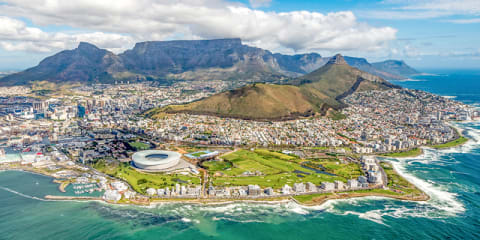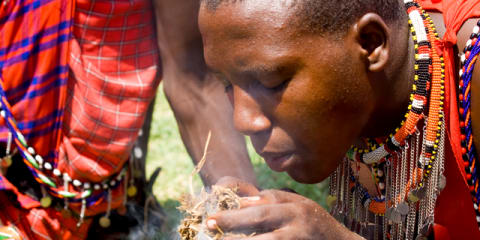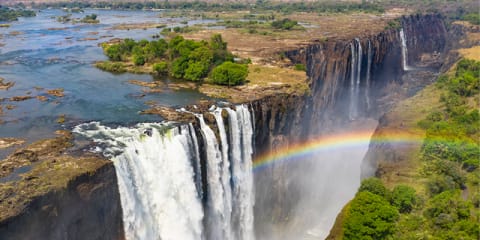 Zimbabwe
Zimbabwe
Political tumult has darkened Zimbabwe's urban centers, yet this country vigorously protects parks and wildlife. Above all else is the stunning Victoria Falls on the Zambezi. Learn of the Shona, Zimbabwe's earliest inhabitants and still its largest ethnic group, with their characteristic dry stone architecture at the Great Zimbabwe ruins of Masvingo.
Highlights
- Victoria Falls
Lying on the border of Zimbabwe and Zambia, Victoria Falls is one of the most fantastic attractions in Africa and one of the most incredible waterfalls in the world. Known as the "Smoke that Thunders" due to its rising mist and roaring waters, this UNESCO World Heritage Site holds the record for the world's largest curtain of falling water. The ongoing water flow derives from the Zambezi River, which stretches over 1,500 miles long and plummets over 350 feet into a series of gorges below. One of the most well-known spots associated with Victoria Falls is the Devil's Pool, a naturally-made infinity pool that sits right on the edge of the cliffs. Lush and active rainforests surround the falls, and visitors can speculate about the natural wonder on the 1905 Victoria Falls Bridge.
- The Shona
The Shona people are Zimbabwe's earliest inhabitants and, to this day, the country's largest ethnic group. Its tribe members are divided into five clans in the eastern regions of Zimbabwe. 80% of Zimbabwe's total population identifies as Shona people. These tribe members are traditionally agricultural and reside in homes called mushas, individual rounded huts that stand for specialty functions, such as kitchens and living areas. The Shona people are very well known in the arts for their stone sculptures and their creative hand at making pottery. Several ancient stone structures are believed to be built throughout Zimbabwe by this tribe. These stone walls were the foundation of Great Zimbabwe, an 800-hectare city that was once the central trading hub and today is recognized as a UNESCO World Heritage site. <.p>
- Great Zimbabwe ruins of Masvingo
The Great Zimbabwe ruins of Masvingo stand as the most extensive collection of African ruins located south of the Sahara Desert. Situated between the Zambezi and Limpopo Rivers, these ruins of a once-outstanding city are comprised of intricate dry stone turrets, platforms, and stairways. The term "Masvingo" means "fort" in the Shona language and is commonly referred to as "the fort near Fort Victoria." These granite walls are a symbol of culturally great wealth as well as incredible architectural skills. Archaeologist Peter Farlake stated that these ruins display "an unparalleled architecture elsewhere in Africa or beyond."
- Zambezi River
Crossing over six countries (Zambia, Angola, Namibia, Botswana, Zimbabwe, and Mozambique) and spilling over a handful of waterfalls, the Zambezi River is Africa's 4th largest river, running the length of over 1,500 miles. This sprawling river is also the largest river that flows into the Indian Ocean from Africa. This "River of Life" supports millions of people that inhabit the surrounding areas. These locals thrive on fishing in the river's waters and the rich floodplain soils. The Zambezi River is home to only a few bridges, with the most impressive and well-known bridge, the Victoria Falls Bridge. Visitors to the river can spot various wildlife on the banks and in the surrounding forests or sit and enjoy the peaceful landscape.
Fast Facts
Already booked on one of our packages to Zimbabwe? See everything you need to know before you go.
| Overview | Capital: Harare |
| Entry requirements | Please see our Entry Requirements page. |
| Staying Healthy | Malaria Malaria is present in Zimbabwe. Take precautions against getting mosquito bites. Speak with your doctor about taking a prescription medicine (before, during, and after your trip) to prevent malaria. CDC Malaria guidance: Zimbabwe Yellow Fever CDC Guidance by country: Zimbabwe Proof of Yellow Fever Vaccination is required for travelers arriving to Zimbabwe from a country with risk of Yellow Fever transmission. This includes airport transits or layovers of more than 12 hours in countries with a Yellow Fever risk. World Health Organization, List of Yellow Fever Endemic Countries Do not swim in any freshwater such as lakes or rivers to avoid parasites. |
| Weather | Zimbabwe is a year-round destination. April thru October is very hot and dry. The Falls tend to be their least impressive, although game viewing is ideal during this period. The rainy season is November through March. Botanical enthusiasts will enjoy the lush, green vegetation during this period. Zimbabwe's weather is most comfortable right after the rainy season in May and June. The grass is highest then, making game viewing difficult and Victoria Falls is shrouded in mist. |
| Tipping | In restaurants, tip 10-15%. |
| Money & Credit Cards | The official currency in Zimbabwe is the Zimbabwe dollar. Cash in US Dollars is widely accepted and preferred for your shopping needs while in destination. Credit card use and acceptance is limited and inconsistent (only available at selected stores and hotels). Per the US State Department, only Zimbabwe bank cards are accepted at local bank and ATMs and therefore travelers should not expect to have access to cash from automated teller machines. Important note: Foreign cash may be exchanged to the local currency at the bank or exchange bureaus. We suggest that you only exchange enough cash to cover any incidental during your stay in Zimbabwe. It is recommended to have cash when visiting Victoria Falls, as the ATMs sometimes limit the amount of cash allowed to withdraw. Be sure to call your credit card providers to let them know you will be traveling abroad, the places you’ll be visiting and the dates of your trip. This is important for your own protection. Always notify your bank prior to departure to avoid any problems using your credit or debit card while traveling. |
| Shopping | Shop for minerals, jewelry, dolls, woven hats, wood carvings, copper plaques, wooden spoons, safari clothing, baskets, beads, stone sculptures, and snuffboxes. Ivory has been problematic, and some countries do not allow its import. |
| Electricity & Power Adapters | 220 volts. Plug D & G. You will need a voltage converter and plug adapter in order to use U.S. appliances. We recommend getting a universal adapter and converter kit. Learn more about electrical standards around the world. |
| Cell Phones & Internet | Want to take your cell phone, tablet or laptop, but not sure how to get cell service or wifi? Read up on using your cell phone abroad and the top 5 ways to get Internet abroad. |
| Did you know? |
|
Tours & Packages
- Destinations: Zimbabwe
- including closed packages



Trip Reviews & Photos
We love hearing your stories and seeing your photos! Check out our entire fan photo gallery and upload your photos.

 Lying on the border of Zimbabwe and Zambia, Victoria Falls is one of the most fantastic attractions in Africa and one of the most incredible waterfalls in the world. Known as the "Smoke that Thunders" due to its rising mist and roaring waters, this UNESCO World Heritage Site holds the record for the world's largest curtain of falling water. The ongoing water flow derives from the Zambezi River, which stretches over 1,500 miles long and plummets over 350 feet into a series of gorges below. One of the most well-known spots associated with Victoria Falls is the Devil's Pool, a naturally-made infinity pool that sits right on the edge of the cliffs. Lush and active rainforests surround the falls, and visitors can speculate about the natural wonder on the 1905 Victoria Falls Bridge.
Lying on the border of Zimbabwe and Zambia, Victoria Falls is one of the most fantastic attractions in Africa and one of the most incredible waterfalls in the world. Known as the "Smoke that Thunders" due to its rising mist and roaring waters, this UNESCO World Heritage Site holds the record for the world's largest curtain of falling water. The ongoing water flow derives from the Zambezi River, which stretches over 1,500 miles long and plummets over 350 feet into a series of gorges below. One of the most well-known spots associated with Victoria Falls is the Devil's Pool, a naturally-made infinity pool that sits right on the edge of the cliffs. Lush and active rainforests surround the falls, and visitors can speculate about the natural wonder on the 1905 Victoria Falls Bridge. The Shona people are Zimbabwe's earliest inhabitants and, to this day, the country's largest ethnic group. Its tribe members are divided into five clans in the eastern regions of Zimbabwe. 80% of Zimbabwe's total population identifies as Shona people. These tribe members are traditionally agricultural and reside in homes called mushas, individual rounded huts that stand for specialty functions, such as kitchens and living areas. The Shona people are very well known in the arts for their stone sculptures and their creative hand at making pottery. Several ancient stone structures are believed to be built throughout Zimbabwe by this tribe. These stone walls were the foundation of Great Zimbabwe, an 800-hectare city that was once the central trading hub and today is recognized as a UNESCO World Heritage site. <.p>
The Shona people are Zimbabwe's earliest inhabitants and, to this day, the country's largest ethnic group. Its tribe members are divided into five clans in the eastern regions of Zimbabwe. 80% of Zimbabwe's total population identifies as Shona people. These tribe members are traditionally agricultural and reside in homes called mushas, individual rounded huts that stand for specialty functions, such as kitchens and living areas. The Shona people are very well known in the arts for their stone sculptures and their creative hand at making pottery. Several ancient stone structures are believed to be built throughout Zimbabwe by this tribe. These stone walls were the foundation of Great Zimbabwe, an 800-hectare city that was once the central trading hub and today is recognized as a UNESCO World Heritage site. <.p> The Great Zimbabwe ruins of Masvingo stand as the most extensive collection of African ruins located south of the Sahara Desert. Situated between the Zambezi and Limpopo Rivers, these ruins of a once-outstanding city are comprised of intricate dry stone turrets, platforms, and stairways. The term "Masvingo" means "fort" in the Shona language and is commonly referred to as "the fort near Fort Victoria." These granite walls are a symbol of culturally great wealth as well as incredible architectural skills. Archaeologist Peter Farlake stated that these ruins display "an unparalleled architecture elsewhere in Africa or beyond."
The Great Zimbabwe ruins of Masvingo stand as the most extensive collection of African ruins located south of the Sahara Desert. Situated between the Zambezi and Limpopo Rivers, these ruins of a once-outstanding city are comprised of intricate dry stone turrets, platforms, and stairways. The term "Masvingo" means "fort" in the Shona language and is commonly referred to as "the fort near Fort Victoria." These granite walls are a symbol of culturally great wealth as well as incredible architectural skills. Archaeologist Peter Farlake stated that these ruins display "an unparalleled architecture elsewhere in Africa or beyond."  Crossing over six countries (Zambia, Angola, Namibia, Botswana, Zimbabwe, and Mozambique) and spilling over a handful of waterfalls, the Zambezi River is Africa's 4th largest river, running the length of over 1,500 miles. This sprawling river is also the largest river that flows into the Indian Ocean from Africa. This "River of Life" supports millions of people that inhabit the surrounding areas. These locals thrive on fishing in the river's waters and the rich floodplain soils. The Zambezi River is home to only a few bridges, with the most impressive and well-known bridge, the Victoria Falls Bridge. Visitors to the river can spot various wildlife on the banks and in the surrounding forests or sit and enjoy the peaceful landscape.
Crossing over six countries (Zambia, Angola, Namibia, Botswana, Zimbabwe, and Mozambique) and spilling over a handful of waterfalls, the Zambezi River is Africa's 4th largest river, running the length of over 1,500 miles. This sprawling river is also the largest river that flows into the Indian Ocean from Africa. This "River of Life" supports millions of people that inhabit the surrounding areas. These locals thrive on fishing in the river's waters and the rich floodplain soils. The Zambezi River is home to only a few bridges, with the most impressive and well-known bridge, the Victoria Falls Bridge. Visitors to the river can spot various wildlife on the banks and in the surrounding forests or sit and enjoy the peaceful landscape.